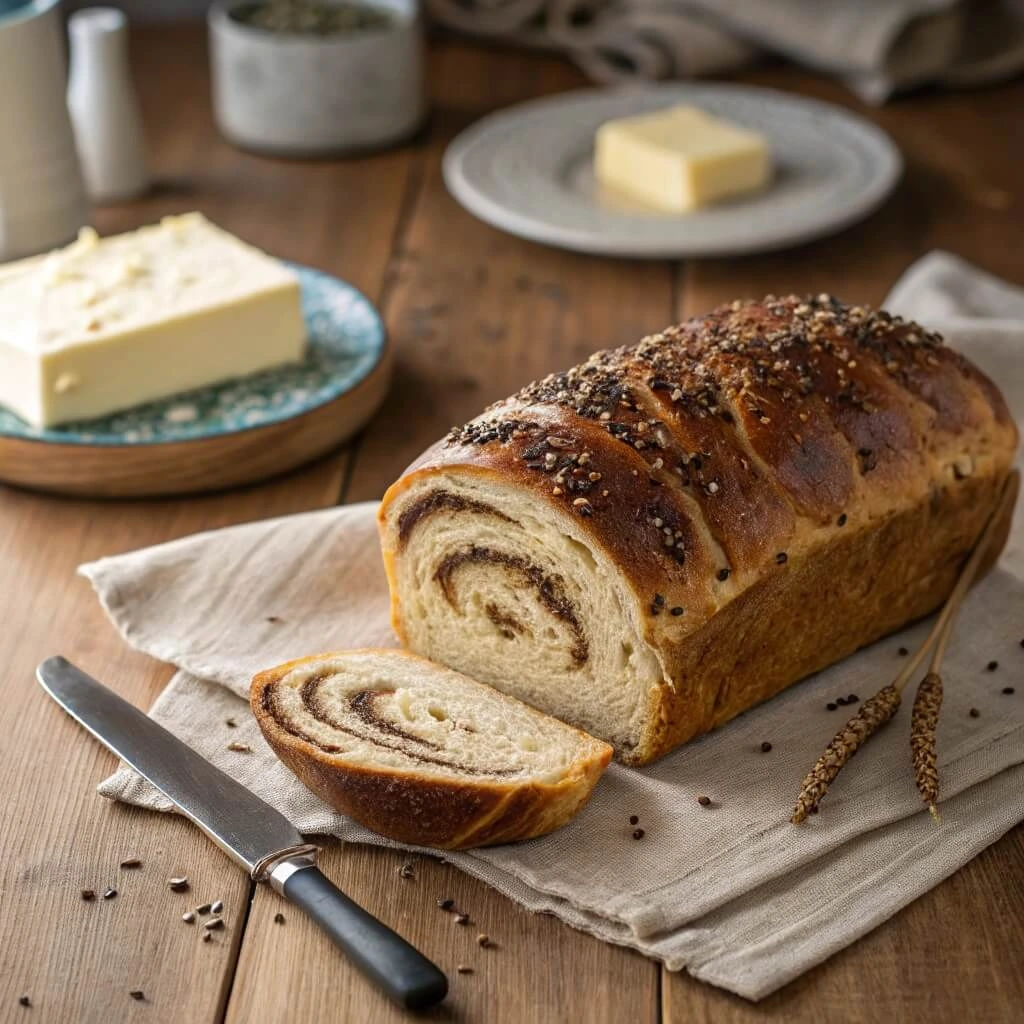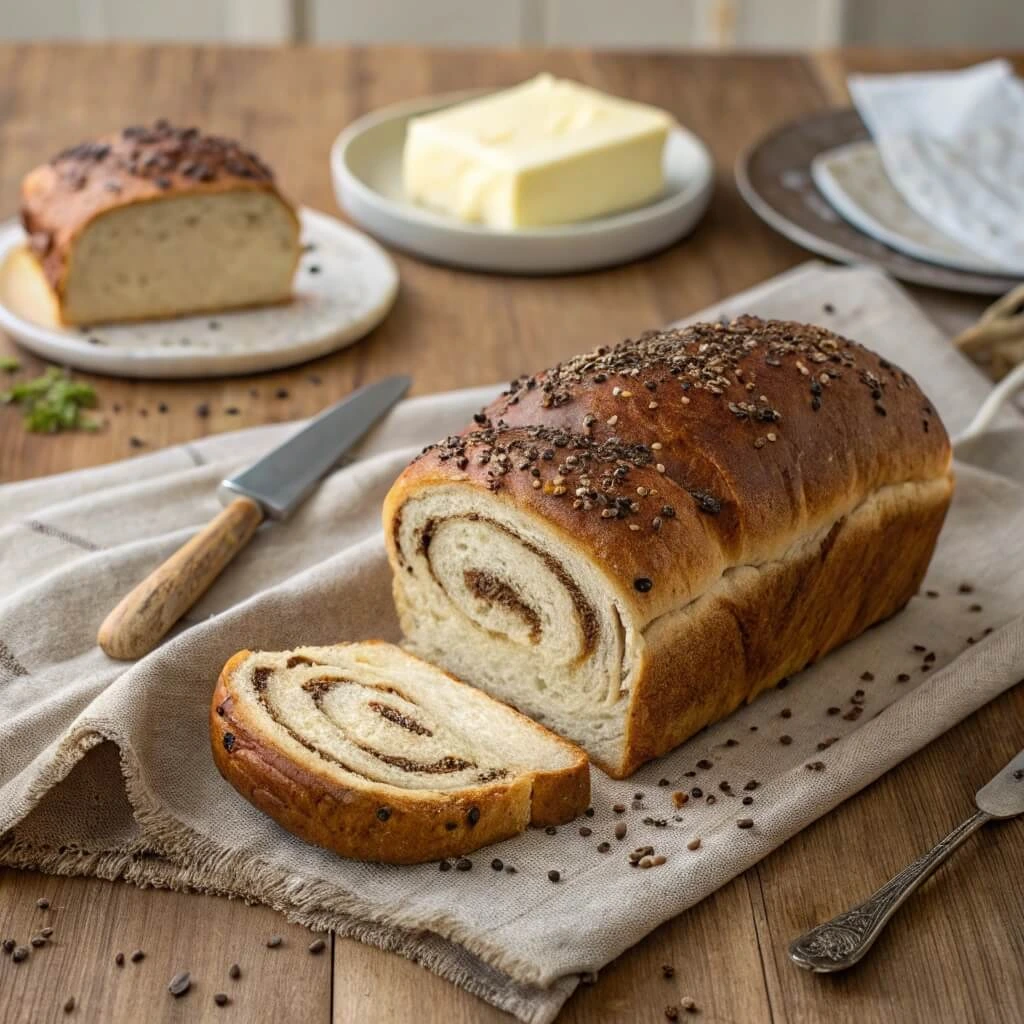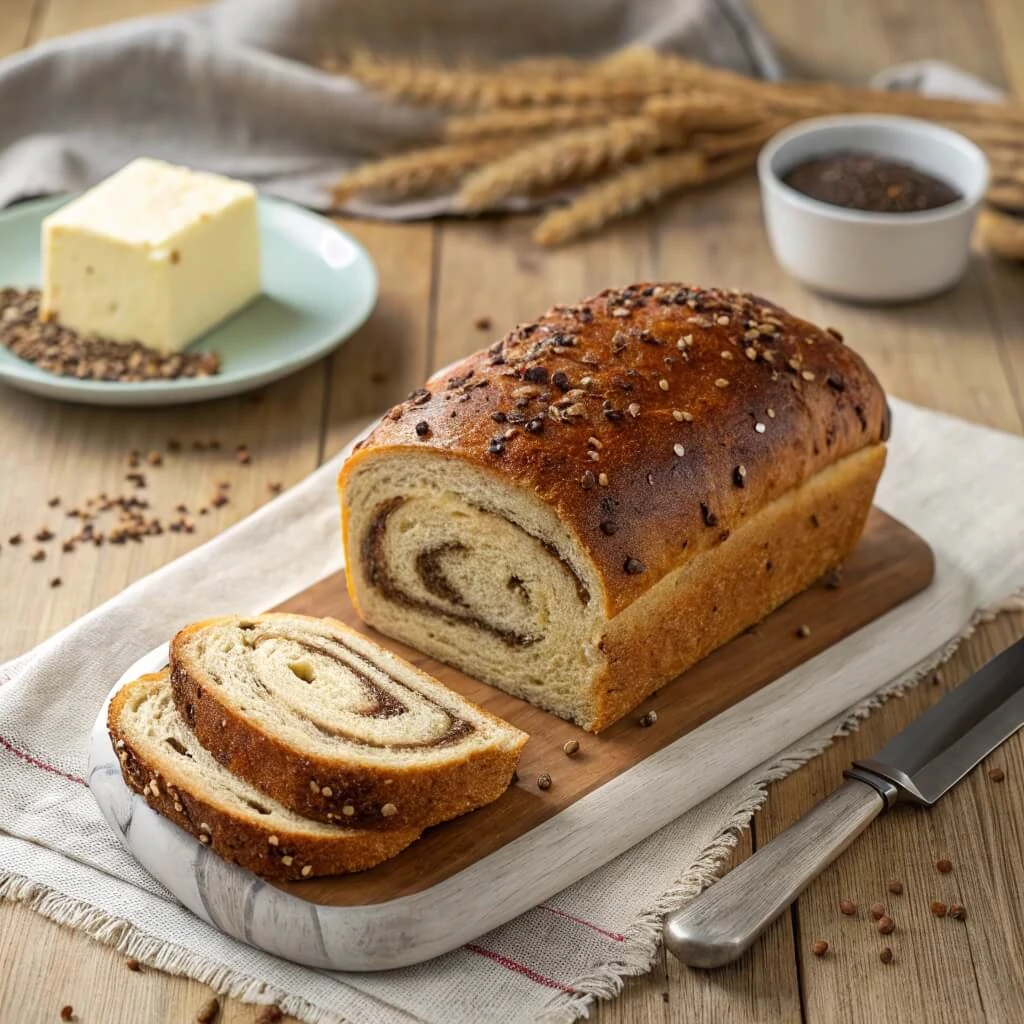Marble Rye Bread: 6 Foolproof Tricks for a Stunning Swirl
Marble rye bread is a unique and flavorful variation of traditional rye bread. Known for its striking swirl pattern, this loaf combines the robust taste of rye with a hint of sweetness from light, soft wheat dough. The contrast between the dark and light sections adds visual appeal and enriches the flavor, making it a delightful addition to any meal. Whether enjoyed on its own or paired with your favorite deli meats, it offers an unforgettable experience.
Why choose homemade marble rye bread? Making it at home allows you to control the quality of ingredients and the bread’s texture. Unlike store-bought versions, homemade marble rye has the advantage of being fresh, fragrant, and customizable. The process of swirling the rye and wheat doughs together also ensures a perfect blend of flavors in every bite.
Homemade marble rye bread offers a perfect balance of flavors and textures, with a beautiful swirl pattern. The earthy rye contrasts with the mildness of wheat, creating a unique twist on any dish. Enjoy it as toast for breakfast, paired with soups, or in a classic sandwich. Baking it at home allows you to experiment with ingredients, making the process as rewarding as the final result.

Ingredients and Tools for the Perfect Marble Rye Bread
Essential Flours: Light Rye, Dark Rye, and King Arthur Pumpernickel Flour
To achieve the perfect marble rye bread, the type of flour you use is crucial. Light rye flour gives the bread a delicate texture, while dark rye flour contributes to its rich, earthy flavor. Additionally, incorporating King Arthur pumpernickel flour enhances the bread with a slightly sweet, full-bodied taste, creating a more complex loaf. The combination of these flours helps achieve the desired marbling effect and balance of flavors.
Choosing the Right Sweeteners and Flavor Enhancers
Sweeteners like molasses or honey are commonly used in marble rye bread to enhance the flavor and add a slight sweetness that complements the richness of the rye flour. These sweeteners also improve the dough’s texture, making it softer and easier to handle. Adding caraway seeds can further enhance the classic rye flavor, providing that signature spice. Opting for the right sweeteners and flavor enhancers will elevate the overall taste.
Must-Have Tools for Perfect Swirls
Achieving the signature swirl pattern of marble rye bread requires essential tools. A clean countertop or work surface is necessary for kneading and dividing the dough. A bench scraper or dough cutter helps split the dough into equal portions of light rye and dark rye. A rolling pin ensures even layering before shaping. These tools, combined with patience and technique, help create the perfect loaf with beautiful swirls.
Foolproof Steps to a Stunning Swirl
How to Prepare and Knead the Dough
To make marble rye bread, start by preparing the dough for both the light and dark rye portions. Mix the dry ingredients, including rye and pumpernickel flours, with yeast and salt. Add water and knead each dough separately until smooth and elastic. Kneading is essential for gluten development, ensuring a soft and chewy texture. Allow the doughs to rise separately until doubled in size.
The Art of Layering and Swirling Rye and Pumpernickel Doughs
Once your dough has risen, it’s time to combine the light rye and dark rye doughs. Flatten each dough portion into a rectangular shape, then layer the dark rye dough over the light rye dough. Carefully roll the dough into a log shape, ensuring both doughs are incorporated. To achieve the marbled effect, gently twist or fold the dough, creating a beautiful swirl pattern. Be careful not to overwork the dough, as this can disrupt the swirl.
Proofing and Baking for the Perfect Texture
After shaping the marble rye bread, allow it to proof for a final rise in a warm area until it puffs up. Once proofed, bake in a preheated oven at the right temperature for a crisp, golden-brown crust. For the best results, bake until the bread reaches an internal temperature of around 190°F, ensuring a soft yet hearty loaf with the perfect texture.

Serving and Pairing Ideas for Marble Rye Bread
The Best Ways to Enjoy Marble Rye Toast
Marble rye toast is a delicious, versatile treat that can be enjoyed in numerous ways. The unique swirl of dark and light rye makes it perfect for toasting, providing a delightful crunch while maintaining the bread’s moist interior. Spread a thin layer of butter or cream cheese on top for a simple, yet satisfying snack. For added flavor, top with fresh herbs, a drizzle of honey, or even a poached egg. The slightly sweet and savory taste of marble rye toast makes it ideal for breakfast or a quick snack at any time of day.
Pairing Marble Rye with Soups, Sandwiches, and Deli Meats
Marble rye bread’s robust flavor and texture make it an excellent pairing for a variety of meals. It pairs wonderfully with soups, especially creamy ones like tomato or potato leek. The bread’s hearty nature also complements sandwiches, particularly those featuring deli meats like pastrami, corned beef, or turkey. For a classic deli experience, stack marble rye with Swiss cheese, mustard, and your choice of meat for a delicious, flavorful sandwich. Whether toasted or fresh, marble rye bread enhances the flavors of any savory dish.
Creative Uses for Leftover Marble Rye Bread
Leftover marble rye bread can be repurposed into creative, delicious dishes. Transform it into croutons by cutting it into cubes, seasoning with olive oil and herbs, and baking until crispy. You can also make bread pudding, using the unique flavors of marble rye to create a savory version with cheese, eggs, and herbs. Another idea is to make French toast, where the slight sweetness of the rye complements the eggy coating. These creative uses help reduce food waste while making the most of your bread.
Common Questions and Troubleshooting Tips
Why Didn’t My Marble Rye Swirl Properly?
If your marble rye swirl didn’t form as expected, there could be a few reasons for this. First, ensure that the doughs are of equal size and thickness when layering, as uneven portions may result in an uneven swirl. Another common issue is overworking the dough, which can cause the layers to blend instead of creating distinct swirls. Finally, be mindful of how you’re rolling and twisting the dough—gentle movements are key to preserving the swirl pattern. With a little practice, you’ll master the art of the perfect marble rye bread swirl.
Can I Make a Sourdough Version of Marble Rye?
You can make a sourdough version of marble rye bread by using a sourdough starter instead of commercial yeast for a tangy, complex flavor. Incorporate the starter into both the light rye and dark rye dough mixtures, adjusting hydration and fermentation times as needed. Though it requires more time and attention, the result is a flavorful, tangy sourdough version with an irresistible texture.
How to Store and Keep Marble Rye Bread Fresh?
To keep your marble rye bread fresh, store it properly. For short-term use, wrap the bread in a clean cloth or plastic bag and keep it at room temperature. For longer storage, slice the bread, place it in an airtight container or freezer bag, and store it in the freezer. When you’re ready to enjoy it, toast or thaw the slices for a fresh, delightful experience. Proper storage helps maintain the bread’s delicious flavor and moist texture for longer.

Conclusion
Homemade marble rye bread offers a delightful balance of flavors, textures, and visual appeal that store-bought versions simply can’t match. The unique swirl pattern of dark and light rye dough, combined with its hearty, slightly sweet flavor, makes this bread a standout addition to any meal. Whether enjoyed as simple toast, paired with soups, or served as a sandwich, it brings both comfort and sophistication to your table. Making it at home allows you to experiment with ingredients, ensuring each loaf is tailored to your liking. The process of crafting marble rye bread is as rewarding as the final result, making it an enjoyable baking experience for any home cook.
FAQ
How does marble rye bread differ from regular rye bread?
Marble rye bread is a variation of regular rye bread, distinguished by its unique swirl pattern. It combines both light and dark rye doughs, typically with an addition of wheat flour in the light portion. This contrast in doughs not only gives marble rye bread a striking visual appeal but also a more complex flavor compared to traditional rye bread. The marbling adds a slight sweetness and lighter texture, making it a more versatile choice for different dishes.
Can I use whole wheat flour instead of rye?
While you can substitute whole wheat flour for rye in marble rye bread, the flavor and texture will be different. Whole wheat flour has a nutty, slightly sweet flavor and denser texture compared to rye flour. Rye flour is essential for achieving the signature tangy taste and dense crumb of marble rye bread. If you’re seeking a similar effect, consider using a blend of rye and whole wheat flour, but for the true experience, rye is the better option.
What is the best way to achieve a perfect swirl in marble rye?
While you can substitute whole wheat flour for rye in bread, the flavor and texture will be different. Whole wheat flour has a nutty, slightly sweet flavor and denser texture compared to rye flour. Rye flour is essential for achieving the signature tangy taste and dense crumb. If you’re seeking a similar effect, consider using a blend of rye and whole wheat flour, but for the true experience, rye is the better option.
Is marble rye bread healthier than white bread?
Marble rye bread is generally healthier than white bread due to its use of rye flour, which contains more fiber, vitamins, and minerals than refined white flour. Rye bread has a lower glycemic index, making it a better option for maintaining stable blood sugar levels. While marble rye still contains some wheat flour, it offers more nutritional benefits compared to white bread, particularly when made with whole-grain rye. However, as with any bread, portion control is key to making the healthiest choice.
Can I make this recipe gluten-free?
Making a gluten-free version of marble rye bread can be challenging, as rye flour contains gluten, which contributes to the bread’s texture and rise. However, you can try using a gluten-free flour blend in place of rye flour, adding xanthan gum to help with structure. Keep in mind that the flavor and texture of gluten-free marble rye bread will differ from the traditional version, but with the right modifications, you can still enjoy a gluten-free alternative.

